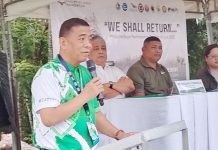TACLOBAN CITY – With the “latest wave” of heavy downpour, the United Nations High Commissioner for Refugees (UNCHR) stressed the need to find long-term solutions for families displaced by supertyphoon Yolanda.
During a briefing held January 25, Joel Andersson, UNCHR’s head of Yolanda operations in Tacloban said that many families are still in evacuation centers and some are still taking shelter in tents waiting to be moved to temporary and permanent shelters.
“Agaton, a typhoon recently hit the country tested again the resilience of Filipinos still recovering from the devastation brought on by typhoon Yolanda in November. While the commitment of the Philippine government to help rebuild the lives of affected population is truly remarkable and should not be underestimated, we are reminded the need to do more for finding durable solutions,” Andersson said.
The UNHCR made the statement after receiving reports that more than a thousand persons in Guiuan, Eastern Samar had to be evacuated from tents and bunkhouses to public buildings and schools last week the low pressure area and storm dumped rains.
“The incessant rains flooded emergency shelters and strong winds that toppled tents are a clear reminded that these shelters are not equipped for long term residency and are unable to sustain heavy weather over a period of time,” he added.
“The Philippines government and the survivors should be assisted in the provision of safe and permanent shelters for people affected by this series of natural disasters.”
Citing government reports, the UNCHR said that Yolanda’s fierce winds and storm surges had totally destroyed 550,928 homes, displacing 4.1 million people along its path.
As of this week, more than 440,000 families have received emergency shelter materials such as family tents and plastic sheets. Also provided were solar lanterns, blankets, jerry cans, and kitchen sets distributed to typhoon-stricken villages in Leyte, Samar, Eastern Samar, Iloilo and northern Cebu.
The UN official noted that people are still dependent on humanitarian support, particularly to rebuild their homes. About 14 million survivors, to include 4.1 million persons were displaced on Yolanda’s aftermath, according to UN.
By: SARWELL Q. MENIANO



